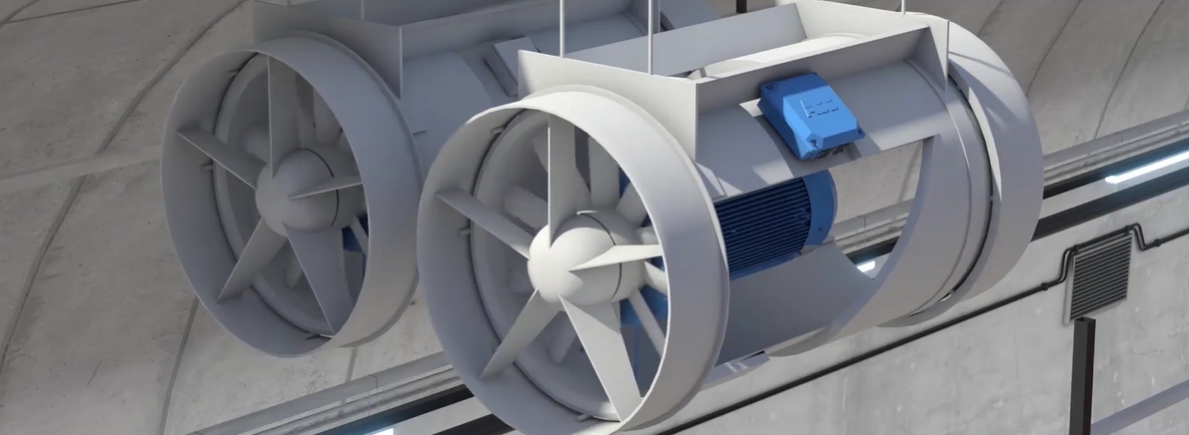Removing excess water and providing clean, fresh air are critical for the safety of road and rail tunnels, but this often involves unnecessarily high energy costs for operators.
Traditional ventilation and drainage systems used electric motors controlled by mechanical throttling to power fans and water pumps that usually ran at full speed 24 hours a day, irrespective of traffic volume or flood risk.
“Removing harmful emissions and limiting water inundation are essential for the smooth and safe running of vehicles through tunnels,” said Josh Paikada, Strategic Business Development Manager at ABB Australia. “But the operation is very wasteful if the motors aren’t programmed to continuously adjust the speed to match the application requirements.”
The solution is a variable speed drive (VSD) that allows the control system to automatically change the fan’s speed in real time to precisely modulate airflow based on the ventilation demands.
“Typically, a fan operating at 80 per cent speed, uses half as much energy as it would at full speed,” Paikada said. “And using an ABB VSD can cut energy use by between 30 and 80 per cent during normal operation of a tunnel”.

When combined with sensors throughout the tunnel, the drives adjust the fans to operate in the most energy-efficient way. They also limit the starting current of the motors, relieving pressure on the system and reducing the size of the equipment required and the overall cost.
A critical function of the fans is to extract smoke when a fire breaks out in the tunnel. In such an enclosed space, temperatures can reach 400°C, and these motors can withstand that heat.
“Sensors on the fans detect the thick, toxic plumes of smoke and trigger an alarm that speeds up the fan,” said ABB Australia Product Specialist for Low Voltage Motors Goutam Agashe. “We supply motors based on specifications and fire temperature assessments from the tunnel operators.”
At the moment, such motors are available in three energy efficiency standards – IE2, IE3 and IE4.
Motors that meet IE4 efficiency standards are not only suitable for continuous use applications such as tunnels but also consume less energy which translates to cost savings due to lower electricity consumption and reduced carbon emissions.
“An IE4 motor may have a premium upfront cost, but the overall cost of ownership (inclusive of purchase price of the motor, cost of running the motor, and cost savings from not running the motor when it’s not required), significantly outweighs the purchase price alone,” Agashe said. “Hence IE4 motors are recommended over other less efficient motors.”
Minimising dirty power
One of the biggest issues when using VSDs for tunnel ventilation is harmonics – also known as “dirty power” – where extra frequencies in the electrical circuit distort the AC sine wave and cause stress in cables and equipment.
It can lead to flickering lights, circuit breakers tripping, overheated cables and interruptions to the power supply. It also reduces the lifespan of generators, transformers and motors, and degrades the whole electrical system.
“ABB’s ultra-low harmonic drive (ULH drive) for heating, ventilation and air-conditioning applications, ensures environmental control and power quality by filtering out harmonics to less than five per cent of current distortion so that they’re within the mandatory limits specified by the electricity distributor,” Paikada said.
“Without it, a tunnel operator would have to install a range of additional components, which is a time-consuming and costly exercise given that a 10 km tunnel normally has around 30 fans.”
Extra costs incurred might include:
- Comprehensive system analysis and monitoring
- Harmonic filters
- Equipment upgrades or replacements
- Design modifications
- Engaging consultants or engineers specialising in power quality
Several of ABB’s ULH drive VDSs are being used for the tunnel exhaust fans, long egress passage fans and cross passage pressurisation fans in the nine-kilometre twin tunnels in Sydney’s M4-M5 Link, which form part of WestConnex, Australia’s largest road tunnel infrastructure project.
Packaged solutions
But ABB’s involvement isn’t restricted to the supply of high-quality machines to tunnel builders and operators.
“There’s a considerable value in working with us for a packaged motor and VSDs to operate pumps and fans in ventilation and drainage systems,” said Jason de Souza, the technology leader’s East Coast Regional Service Manager in Australia. “ABB provides support from the design phase through to operation, remote monitoring and maintenance so everything is in sync and there’s visibility across the entire operation.
“If you have to deal with a range of suppliers then it can become a cumbersome, inefficient operation prone to problems such as two pieces of equipment being incompatible or a fault going undetected. As a leading manufacturer, we can supply a fully packaged solution with guaranteed energy efficiency and correctly sized components for the specific application needs.”
Many ABB customers sign up for ABB Motion OneCare, a service agreement that ensures the smooth running of high-performance motors, generators and VSDs over their lifetime.
“It’s tailored to individual needs so takes away the risk,” de Souza said. “It covers everything that could ever be needed such as spare parts, preventative maintenance, repairs and 24-hour remote data monitoring.
“It also provides performance reports, automated scheduled maintenance and breakdown support. ABB’s experts become responsible for running the whole system in the most economical way, troubleshooting when any problems arise.”
As all data is uploaded to cloud servers, it can be monitored 24 hours a day by ABB’s global network of specialists. That is particularly critical for emergencies and breakdown support because reacting quickly and effectively can save lives.
For more information about these technologies, contact ABB Australia.

